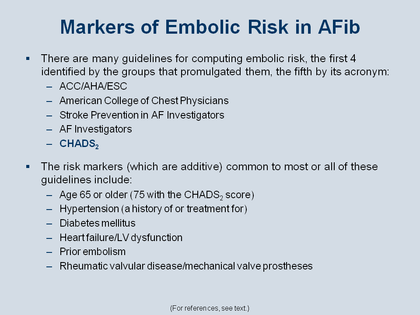Reiffel - Atrial Fibrillation and Stroke: Epidemiology - Figure 23
Markers of Embolic Risk
How do we compute the risk of thromboembolism? The Figure lists the principal guidelines that have been promulgated by the leading professional organizations. [23] [34] [35] [36] [37] [38] Of these it is the CHADS2 scoring system, highlighted in yellow in the top part of the Figure, that has become the most commonly used at this time because it has been promulgated on the basis of retrospective evidence and then confirmed prospectively. The risk factors that almost all of these guidelines have in common are listed in the bottom part of the Figure. Other factors that are generally seen as increasing risk of thromboembolism include female gender and chronic kidney disease; in addition, isolated hypertension (in the absence of other cardiovascular disease) or coronary artery disease with preserved left-ventricular function incur intermediate risk for thromboembolism.
Reiffel JA. Am J Med 2013; 126: 00-00.

